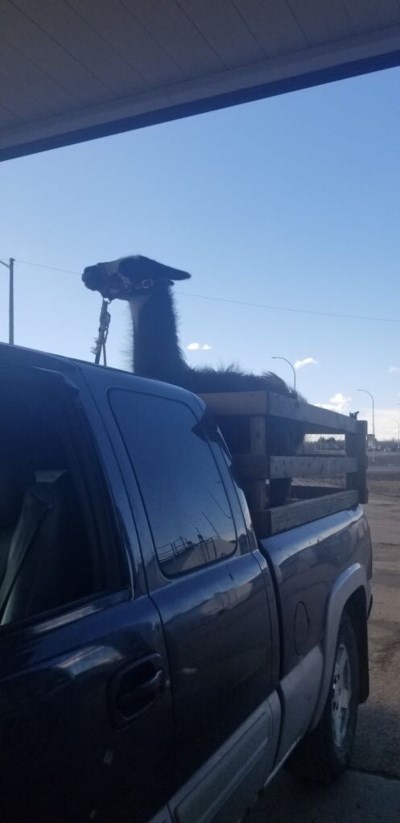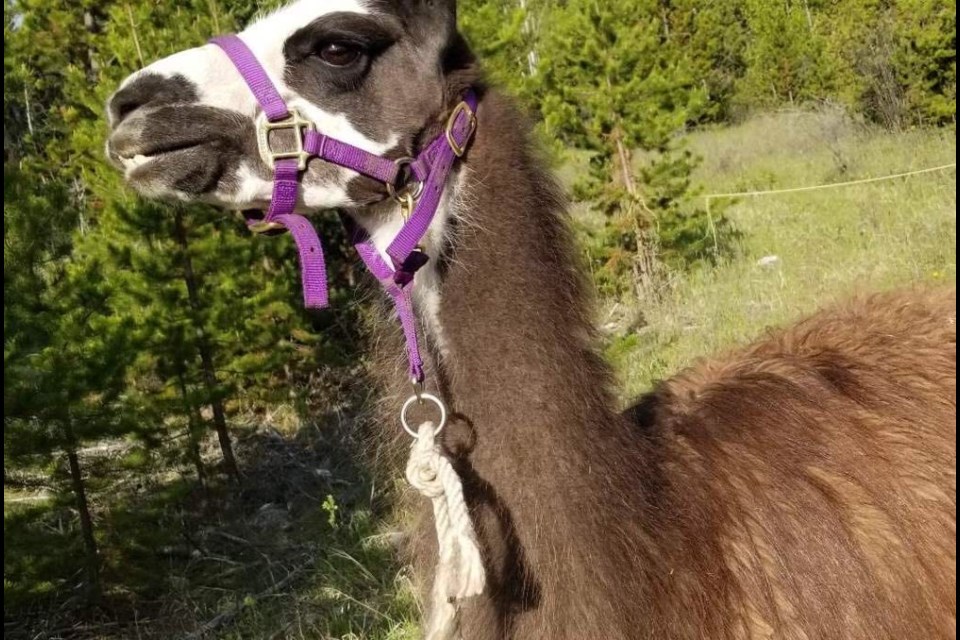Sunday, July 14
After more than a month out of her pen, Coco is home. Jessica Udchitz says in a message she returned to the property today, and they were able to get her into her pen.
She wandered back up our driveway," she says in the message. "We corralled her with lots of people and sticks and I was able to place the rope are her neck."
"She's back in her pen enjoying cold water and veggies."
Saturday, July 13
Clinton, B.C. is not the natural home to llamas, but Coco has decided the wilds outside of town suit her just fine.
The Udchitz family of Clinton has been missing her since June. To say Coco has disappeared, though, isn't quite accurate. She's been spotted quite a lot, actually, but the crafty camelid (llamas are cousins to camels) has evaded capture regularly.
"She's been hiding here or sighted there," says Jessica Udchitz. "We have a spot we meet (our neighbour) and he drives and I sit in the back of the truck."
"We drive up and down the road."
The story begins back in April, when the Udchitzs, who moved to a 25-acre farm outside of Clinton from Calgary five years ago, decided to get a llama — they're good lookout animals, and the Udchitzs have goats. It just worked out Coco was available in Edmonton.
 Coco on her journey to her new home. (via Jessica Udchitz)
Coco on her journey to her new home. (via Jessica Udchitz)That trip. Udchitz recalls clearly seeing drivers and passengers in passing vehicles gawking and snapping photos of Coco as they drove from Edmonton to Clinton.
She was a friendly, well-tempered addition to the family. They could feed her from hand, she wouldn't fight when halters were put on or taken off. Coco would come along to pick Udchitz's 10-year-old son from the bus stop.
Then, in early June, Coco escaped. But she didn't go far. The Udchitzs live near a cross-country ski facility, where Coco seems to spend a lot of time. There's also an unused airstrip.
"She's claimed her territory," Udchitz says. "Our tactic now is to learn her behaviour."
While the trails have been her favourite area, it seems, she's wandered a lot. Aside from regular sightings in the area, she's spent the night sleeping behind a neighbour's barn; the next morning she was gone, but the impression she left was evidence of her overnight stay.
She even came home once, while the Udchitzs were out. She was spotted in front of the Udchitz's front door a week ago and seemed to be checking on her heard. Udchitz raced home and tried using a goat to lure Coco back into the yard.
"When she saw the rope she started running down the driveway," Udchitz says.
However, that wasn't the closest encounter. On one attempt, Udchitz tried lassoing the long-necked animal, only to have her dodge the throw. The loop landed on Coco's back, and then she took off.
Other times she's been just out of arm's reach from the vehicle the Udchitz and others are in (her son and a neighbour are usually helping).
Another time, Udchitz had the rope in hand as her son tried to flush Coco towards her. Coco went for it, taking off toward Udchitz's area, but as Udchitz moved and looked down to get better footing, Coco was already gone.
"I think maybe Coco was a hockey player in a past life," she says. "She just turns on a dime and goes the other way. They're very fast animals. It's said they can run up to 35 miles an hour."
Trapping her hasn't worked either. They've tried a bunch of Coco's favourite foods to lure her, including sweet hay, grain and lettuce, but the llama hasn't bitten.
That said, she seems to be finding food alright.
"Coco looks healthy and happy," Udchitz says. "She doesn't have any stuck in her fur, she doesn't look like she's lost weight; she's certainly not going hungry."
"You can follow pretty close in a vehicle."
They actually tried another tactic, since they could follow in a vehicle on the ski trails, hoping Coco would tire out, but nope. It should be noted llamas are used as pack animals in their native Peruvian home.
The B.C. Conservation Service has been called. Since Coco isn't a wild animal, or local, she's outside their jurisdiction, the service told the Udchitzs.
The missing llama has become the talk of the town, Udchitz says, coming up when at her son's school events, or at the post office.
"My three-year-old isn't shy, she's quick to tell people we have a bad llama," she says.
While she looks healthy, Udchitz is worried about Coco's safety. B.C. has its fair share of predators and dangers, but at the same time llamas are smart and Coco seems to be vigilant and capable of escaping.
"She's not a dummy, she stays in open areas," Udchitz says. "They instinctually find higher ground."
There are two more tactics Udchitz says haven't been tried, but there are reasons for that.
One option is drugs. Sedatives, to be exact. This might be the quicker solution, as the town veterinarian has told Udchitz he's researching what could be used to slow Coco down enough to follow her on horseback and capture her; however, it's a fine balance and usually, veterinarians will only use prescribed sedatives on animals. A prescription can't be written without the veterinarian examining Coco (you can probably see the issue there).
The other option is to trap Coco with lots of people. Udchitz wants to try and surround the escapee with a length of rope and slow close in on her. Even with the help of her kids, neighbours and some visiting family, they haven't had the numbers that would be needed to pull that off, though.
"It's going to take a lot of rope and a lot of people to corral her in," she says. "Since she's not responding to being lured."
Udchitz is hopeful the sedative plan will work soon, and if not, she figures she'll need to organize a large group of people.
If you are in the Clinton area, specifically the Big Bar Road area, and spot a llama, contact Udchitz on Facebook. She's also open to anyone offering help.



